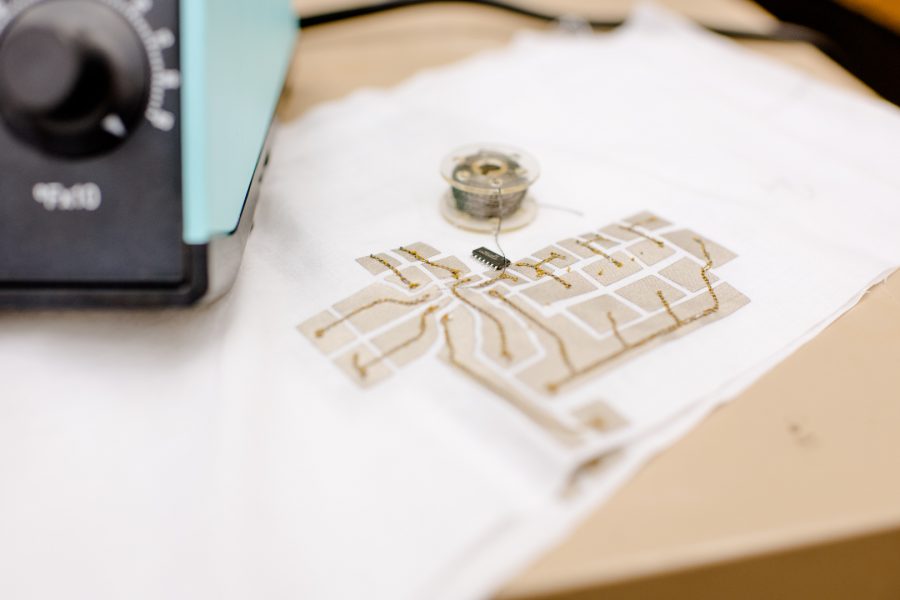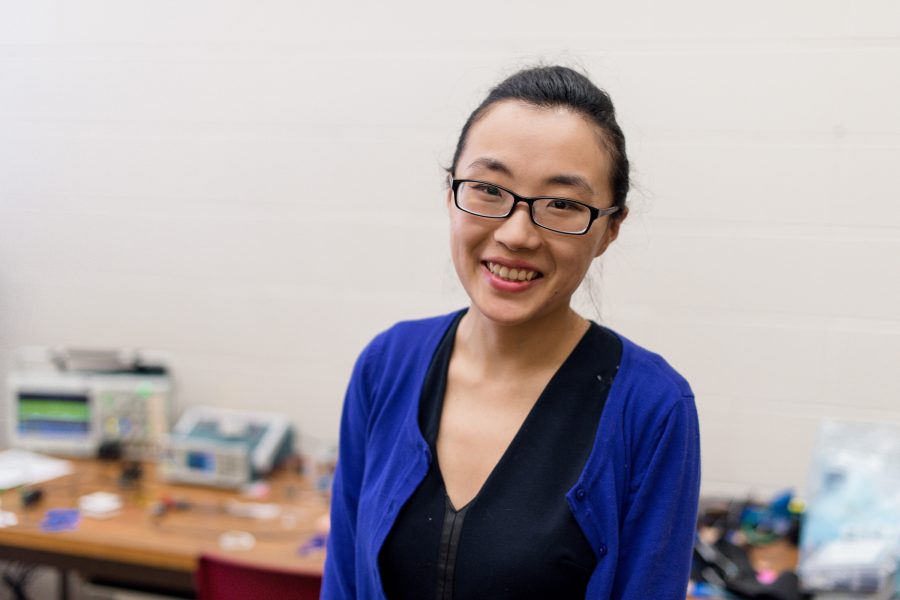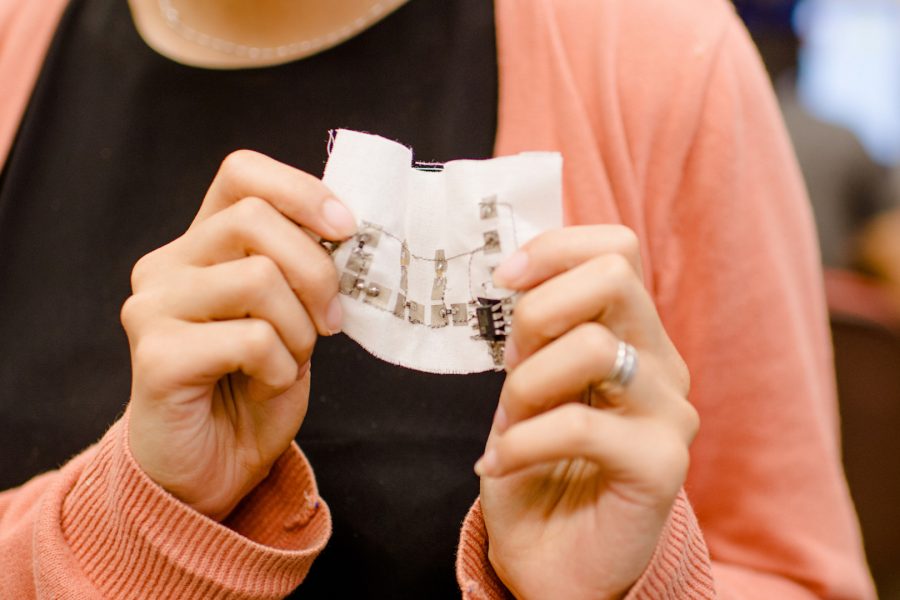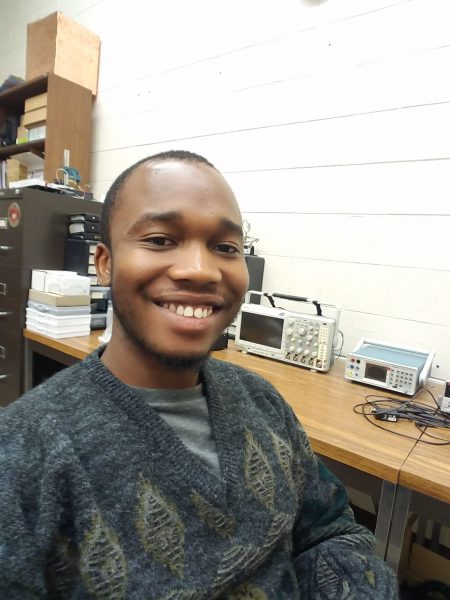
Sarah Sun and George Ochieze generously shared their knowledge on Husky Bites, a free, interactive Zoom webinar hosted by Dean Janet Callahan. Here’s the link to watch a recording of her session on YouTube. Get the full scoop, including a listing of all the (60+) sessions at mtu.edu/huskybites.
What if your medical heart monitor was embroidered right on your shirt, in your favorite design? And what if it was powered by your own movements (no battery required)? And what if you could even design and order it yourself, right on the internet? Get ready to learn all about this, and more.
Join Dean Janet Callahan for supper along with Sarah Sun, an associate professor of mechanical engineering, and George Ochieze, a graduate student researcher in Dr. Sun’s Human-Centered Monitoring Lab at Michigan Tech.

Sun is the lead investigator of three National Science Foundation research grants totaling $1 million focused on wearable electronics. She is also the director of the Center for Cyber-Physical Systems within Michigan Tech’s Institute of Computing and Cybersytems ICC.
“I am passionate about using engineering solutions to solve health problems,” she says. “We’re trying to solve long-existing technical challenges to improve medical devices, and we’re developing new technologies, too, in order to enable more diagnosis solutions.”
One of Sun’s large research projects involves developing new human interfaces for monitoring medical vital signs.
Their goal: to provide a reliable, personalized monitoring system that won’t disturb a patient’s life, whether at home, while driving, or at work. “Right now for patients there’s a real trade-off between comfort and signal accuracy. This tradeoff can interfere with patient care and outcomes, too,” she explains.
Sun hopes to use electrophysiological sensing and motion sensing to help prevent automobile crashes, especially those that occur when drivers accidentally fall asleep at the wheel. According to the National Highway Traffic Safety Administration, while the precise number can be hard to nail down, drowsy driving is a factor in more than 100,000 crashes in the U.S each year, resulting in nearly 1,000 deaths and 50,000 injuries.
First, though, Sun and her team needed to figure out how to overcome a major challenge in monitoring vital signs: motion artifacts, or glitches caused by the slightest patient movement, even shivering, or tremors.

“ECG, a physiological signal, is the gold standard for diagnosis and treatment of heart disease, but it is a weak signal,” Sun explains. “Especially when monitoring a weak signal, motion artifacts arise.”
Sun and her team first set out to discover the mechanism underlying the phenomenon of motion artifacts. Then, they realized they were able to tap into it.
“We not only reduce the influence of motion artifacts but also use it as a power resource,” she says. The result: a sensing device that harvests energy from patient movements.
Sun cites recent progress in the development and manufacturing of smart fabrics, textiles, and garments. “This has opened the door for next-generation wearable electronics—fully flexible systems that can be embroidered directly onto cloth,” she says.
“Feel free to download our .exp files for your own wearable system on cloth manufacturing. The code can be processed by regular sewing machines. Just go online to WEF, our new Wearable Electronics Factory.
By using conductive thread and passive electronics—tiny semiconductors, resistors and capacitors—Sun is able to turn logos into wearable electronics. The stitches themselves become the electronic circuit. Sun and her team can embroider on just about anything flexible, including cloth, foam, and other materials.
Sun is also building a manufacturing network and cloud-based website where stitch generation orders can be made. “In the future, a person can upload their embroidery design to generate stitches, or download certain stitches as needed,” she says. The lab provides coding for the electronics and stitch generation to embroiderers. “Soon any embroidery company will have the potential to manufacture embroidered health monitors,” she says.
These wearable, embroidered ”E-logos” can monitor multiple vital signals. They’re customizable, too.
Sun hopes flexible, wearable electronics will interest a new generation of engineers by appealing to their artistic sides. “This type of embroidery circuit really brings together together craft and functional design.”

George Ochieze is pursuing a master’s degree in Mechatronics and a PhD in Mechanical Engineering. He took Sun’s Introduction to Mechatronics and Robotics course at Michigan Tech last spring. That’s when he discovered his own passion: working with machines and control devices. He joined her research group last summer.
“Mechatronics uses electromechanical systems automated for the design of products and processes,” Ochieze explains. “I picked up my research interest after modeling an RRR manipulator using CAD software. That’s a robot manipulator set up with 3 revolute joints. I had some challenges in controlling the joints, and Dr. Sun gave me some tips. She was very helpful in guiding me through the process, and our mentor/mentee relationship in soft robotics was formed,” says Ochieze.
Soft Robotics involves the design and construction of robots from flexible, compliant materials, drawing from the movements and adaptations of living organisms. Soft robots offer new capabilities, as well as improved safety when working around humans, with potential use in medicine and manufacturing.
Ochieze plans to share a demo on soft robotics during Husky Bites.
“Throughout my growth in the engineering field, I have been surrounded by people who are generous enough to share their knowledge. I look forward to mentoring others like me within this field.”
Professor Sun, when did you first get into engineering? What sparked your interest?
My dad liked to play with old electronics when I was young. I built my first radio receiver in middle school with him although I did not know how those electronics work at that time. This experience really inspired my interest in pursuing an engineering degree. I earned my bachelor’s degree at Tianjin University. It’s located near Beijing, in Tianjin, China, on the Bohai Sea. About six year ago, I earned my PhD in electrical engineering at Case Western Reserve University in Cleveland, Ohio. My doctoral research was on wearable electronics.

Family and Hobbies?
I grew up in Northern China, in a town with a very cold winter climate, but dry. My husband came to Michigan Tech first. He liked the U.P. a lot and told me lots of great things about Tech. It was challenging for me to balance work and life at first, especially with two little kids. My son, Brent, is almost 8 now, and my daughter, Leah, is two. My husband and I both like to design and build stuff, so we enjoy it with our kids, too.
George, how did you first get into engineering? What sparked your interest?
I grew up in Aba, in Abia, Nigeria. Working in my Dad’s fabrication company fostered my interest in the engineering field. At a young age I became familiar with machine operations. I was fascinated with the sequence operation of machines to achieve a desired goal. I started developing cars and movable structures with available materials, leading my fellow students in the design of mechanical components.

Do you do any mentoring or teaching on campus?
I am one of two instructors in Michigan Tech’s Career and Technical Education (CTE) Mechatronics program for local high school juniors and seniors. Even in difficult times during the pandemic, these young scholars show overwhelming potential to conquer the mechatronics field—a glimpse into a welcoming future in engineering. They will go on to find degree pathways at Michigan Tech, and excellent careers in smart manufacturing.
Read and View More
Vital signs—Powering Heart Monitors with Motion Artifacts
Human Centered Monitoring Laboratory (HCML)
Stitches into Circuits (check out the video, below)
